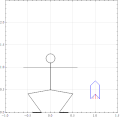File:Jumper2.gif
Jumper2.gif (360 × 353 pixels, file size: 369 KB, MIME type: image/gif, looped, 42 frames, 14 s)
Captions
Captions
Summary edit
| DescriptionJumper2.gif |
English: Reduced frame-rate animation of a leaping "constant-acceleration round-trip", alongside a rocket animation to illustrate the similarity to a non-relativisitc cargo-shuttle operating (on different time and distance scales) between alpha-centauri and earth.
The rocket always points in the direction of the net-acceleration at any given time. Note that the magnitude & direction of the acceleration has very little to do with either the magnitude or the direction of the velocity. |
| Date | |
| Source | Own work |
| Author | P. Fraundorf |
Further notes edit
basic equations edit
This book[1] like most intro physics books lists a set of 3 or 4 constant acceleration equations. The most compact way to summarize these equations may be as follows:
.
Here by definition the Greek letter delta (Δ) preceeding any variable is taken to mean final value minus initial value, i.e. Δz ≡ zfinal-zinitial.
round trip expressions edit

The time elapsed on a "four-leg" constant-acceleration round trip traveling a distance xtarget and back is therefore:
.
Here the maximum speed on this trip is:
.
The target distance can then be written:
.
It might be interesting to ask[2] what anyspeed versions of these 6 equalities look like as well.
As suggested by the table below, the anyspeed versions are more complicated, in part because differences between elapsed map-times (coordinate-time t) and traveler-times (proper-time τ) at high speed (v ~ c) give rise to a distinction between coordinate versus proper velocities (v≡dx/dt versus w≡dx/dτ) and coordinate versus proper accelerations (a versus α) as well as coordinate versus proper times.
At high speeds as one moves from the variables: time, through velocity (change in map-distance per unit time), to acceleration (change in velocity per unit time) the relevance of the "coordinate-versions" of these quantities becomes increasingly parochial (i.e. frame-specific) in comparison to their "proper" analogs (which address matters about the traveler's motion likely to be of more global interest). Hence in the table we haven't bothered to mention either maximum coordinate-speed vmax or the extremes of coordinate-acceleration a, as they are of both limited interest and even messier to write out.
| ⇓get \ given⇒ | target distance |
proper-speed max |
return trav-time |
return map-time
|
|---|---|---|---|---|
target distance |
 |
  |
![{\displaystyle 2{\tfrac {c^{2}}{\alpha }}(\cosh \left[{\tfrac {\alpha }{c}}{\tfrac {\tau }{4}}\right]-1)}](https://wikimedia.org/api/rest_v1/media/math/render/svg/fb716aceccc1ad6b5125e88b2ebdd26e6be3126f)  |
 
|
proper-speed max |
  |
  |
![{\displaystyle c\sinh \left[{\tfrac {\alpha }{c}}{\tfrac {\tau }{4}}\right]}](https://wikimedia.org/api/rest_v1/media/math/render/svg/fb4ed9026933a4da0abc220feaf5d6b959febdd0)  |
 
|
return trav-time |
![{\displaystyle 4{\tfrac {c}{\alpha }}\cosh ^{-1}\left[1+{\tfrac {\alpha }{c^{2}}}{\tfrac {x}{2}}\right]}](https://wikimedia.org/api/rest_v1/media/math/render/svg/1c3738f72a4efc8c53cf6b641aa3561785b24547)  |
![{\displaystyle 4{\tfrac {c}{\alpha }}\sinh ^{-1}\left[{\tfrac {w_{\text{max}}}{c}}\right]}](https://wikimedia.org/api/rest_v1/media/math/render/svg/f0256afa95e53f175cda2932b75cdee26c64d7d5)  |
  |
![{\displaystyle 4{\tfrac {c}{\alpha }}\sinh ^{-1}\left[{\tfrac {\alpha }{c}}{\tfrac {t}{4}}\right]}](https://wikimedia.org/api/rest_v1/media/math/render/svg/27c5eadf9f57fb26fb2b1f46fe299d90528c9d9e) 
|
return map-time |
  |
  |
![{\displaystyle 4{\tfrac {c}{\alpha }}\sinh \left[{\tfrac {\alpha }{c}}{\tfrac {\tau }{4}}\right]}](https://wikimedia.org/api/rest_v1/media/math/render/svg/dd609107061f4afcaa3836ceb76b88a0e4b0ff5d)  |

|
Licensing edit
- You are free:
- to share – to copy, distribute and transmit the work
- to remix – to adapt the work
- Under the following conditions:
- attribution – You must give appropriate credit, provide a link to the license, and indicate if changes were made. You may do so in any reasonable manner, but not in any way that suggests the licensor endorses you or your use.
- share alike – If you remix, transform, or build upon the material, you must distribute your contributions under the same or compatible license as the original.
- ↑ Raymond A. Serway and John W. Jewett (2004 6th ed) Physics for Scientists and Engineers (Brooks/Cole - Thomson Learning, Belmont CA).
- ↑ P. Fraundorf (2012) "A fun intro to 1D kinematics", arXiv:1206.2877 [physics.pop-ph].
File history
Click on a date/time to view the file as it appeared at that time.
| Date/Time | Thumbnail | Dimensions | User | Comment | |
|---|---|---|---|---|---|
| current | 14:55, 24 July 2012 |  | 360 × 353 (369 KB) | Unitsphere (talk | contribs) |
You cannot overwrite this file.
File usage on Commons
The following page uses this file:
Metadata
This file contains additional information such as Exif metadata which may have been added by the digital camera, scanner, or software program used to create or digitize it. If the file has been modified from its original state, some details such as the timestamp may not fully reflect those of the original file. The timestamp is only as accurate as the clock in the camera, and it may be completely wrong.
| GIF file comment | Created by Wolfram Mathematica 8.0 |
|---|
